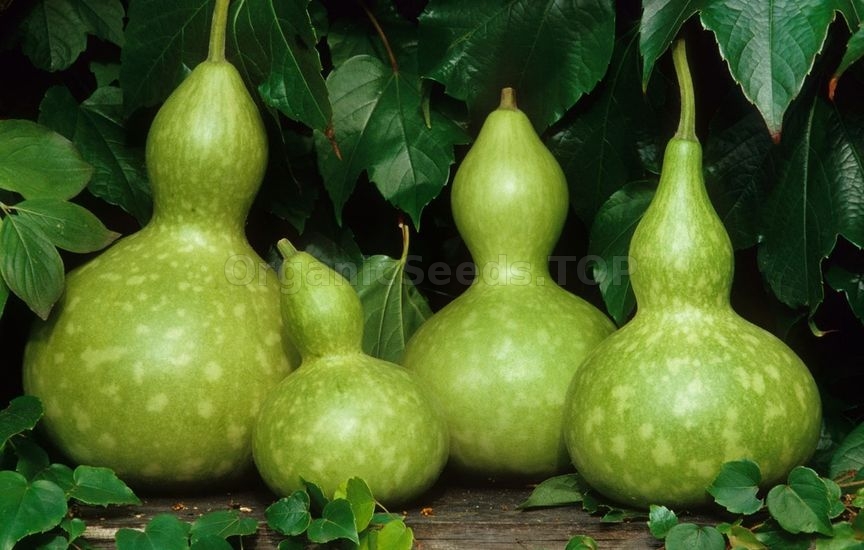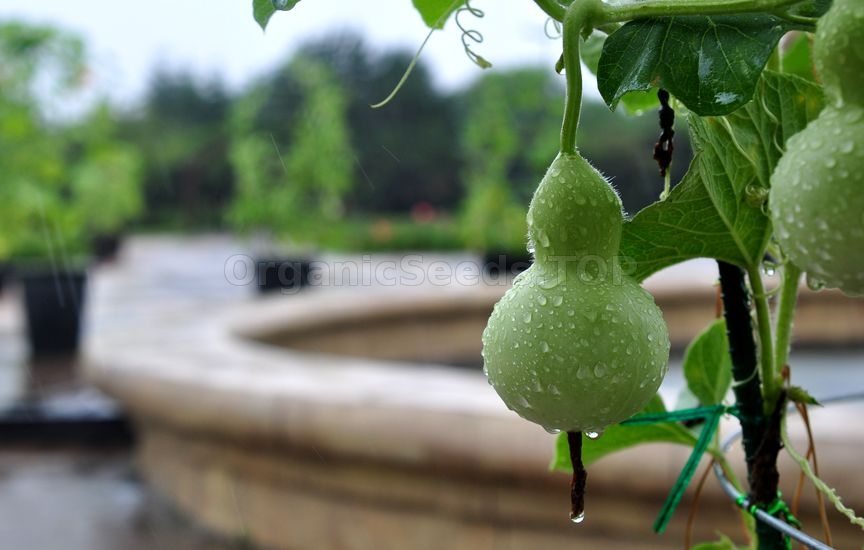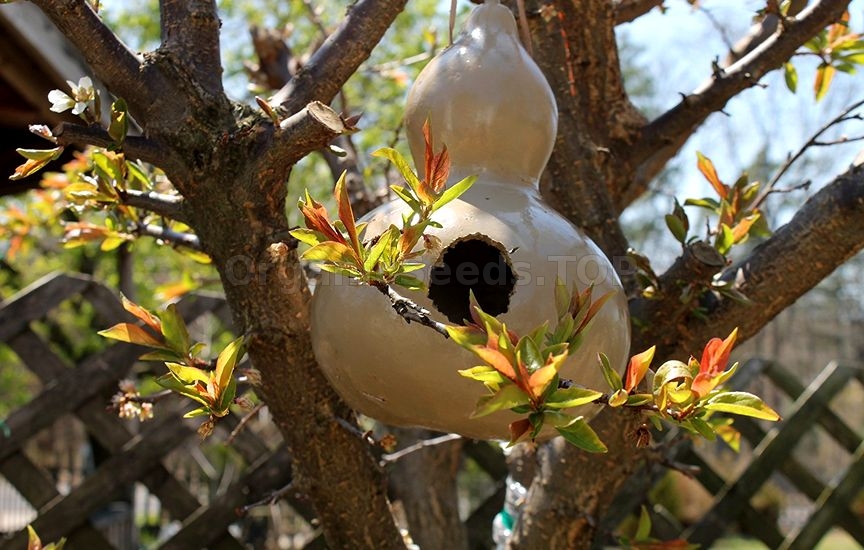Lagenaria (Bottle) Gourds |
 The Lagenaria species are annual vines that can be grown throughout the state. Their fruit are commonly called bottle gourds, but are also called birdhouse gourds, trumpet gourds, calabash gourds, Cucuzzi, and white-flowered gourds. When very young and small, the fruits can be eaten, but it's the fully mature and dried gourds that are valued for the useful and durable containers that can be made from them. Originating in Africa, Lagenaria is closely related to cucumber, squash, and melon, and has become widely distributed around the world. It is an ancient crop and the only one known to have been cultivated in pre-Columbian times in both the Old and New World. Remains of this gourd have been found in Mexico dating from 7000 to 5500 BC and Peru from 10,000 BC; archeological remains in Egypt show gourds being used in about 3500 to 3300 BC. Dried gourds with viable seeds have survived in seawater for at least 200 days, a characteristic that probably aided in the widespread geographic distribution of this vine. Characteristics Lagenaria vines grow fast and use tendrils to climb. They demand space and a sturdy support structure such as a fence, arbor, or even a tree. Lagenaria have attractive white flowers that reach up to 4 inches in diameter and leaves that are up to 15 inches wide and have a velvety texture. The appearance of the fruit varies. The background color is either light green or dark green. They can be solid, striped, or marked with irregular blotches. The size of the fruit varies from 2 to 12 inches in diameter and from 4 to 40 inches in length. The fruit can have a narrow, seedless neck that varies from a few to 15 inches in length, or a wider neck that usually contain seeds. The wider, seed-containing portion of the fruit varies from flat to round, cylindrical, club-shaped, or long and narrow. The round types are usually selected to serve as containers. The young fruits can be eaten as a boiled vegetable. Like all members of the Cucurbit family (including pumpkins, watermelons, and cucumbers) these gourds contain cucurbitacins which are known to be toxic in high concentrations. Cucurbitacins give the fruits a bitter flavor and could cause stomach ulcers. Despite this, these gourds are normally safe to consume. If you do choose to eat your lagenaria gourds, be on the safe side and taste a small piece of the fruit before preparing it and discard any excessively bitter fruit or juice. Planting and Care Lagenaria is grown similarly to squash, and has a growing season of 90-120 days. Seeds should be sown after the last frost; plant them ½ inch deep in raised beds or mounds. Thin the seedlings to one plant every nine feet. Young plants will thrive with watering two or three times a week. A trellis is advised, but vines may be allowed to run on the ground; be sure to add mulch to avoid fruit rotting. Gourd enthusiasts recommend that the vines be pruned when they are between 8-10 feet long to encourage branching and flower production.
If you notice your vine is not looking well there could be a number of culprits. Lagenaria is likely to be attacked by powdery mildew, mosaic virus, fusarium wilt, and fruit rot. Different Lagenaria varieties will vary in their resistance or susceptibility to these problems. Using Dried Gourds If you are planting these vines to use the gourd as a container, the young fruits can be constricted with rubber bands or string to make particular shapes. Some gardeners have been known to grow the gourd inside a bottle, where the fruit assumes the shape of the container.
Gourds should be left to mature on the vine. As fall approaches, discontinue watering and allow the vines to wither and die. When the gourd stems turn brown, cut them off the vine with an inch or more of stem. Gently wash them in a 10:1 solution of water and bleach. Store your gourds somewhere warm and well ventilated where they can dry. The drying process can take up to six months, so be patient. As your gourds dry it is normal to see mold starting to grow; just wash them again with the same water and bleach solution. You'll know a gourd is fully dry when it becomes lightweight and the seeds rattle around inside when the gourd is shaken. Dry gourds can be painted, shellacked, or waxed. A well-finished gourd will be more durable as a container or birdhouse than one that has not been treated in any way. Dried gourds have a variety of uses as pots, bowls, birdhouses, or even musical instruments. Creating a Birdhouse Many types of birds are attracted to birdhouse gourds, such as purple martins, bluebirds, swallows, and woodpeckers. Choose a large gourd when selecting one for a birdhouse. Cut an opening in the side large enough to accommodate the type of bird you wish to attract. Drill four smaller holes in the stem-end of the gourd to provide your birdhouse with ventilation and a place to hang your birdhouse from. Add a few small holes in the bottom of the gourd for drainage as well. Once you have all the holes cut and drilled, your gourd birdhouse can be painted or varnished to make it both functional and beautiful. You may need:«Birdhouse» - Organic Calabash Seeds«Dragon Сhun-Yu» - Organic Calabash Seeds«Speckled Swan» - Organic Calabash SeedsLagenaria seeds |
|
|
